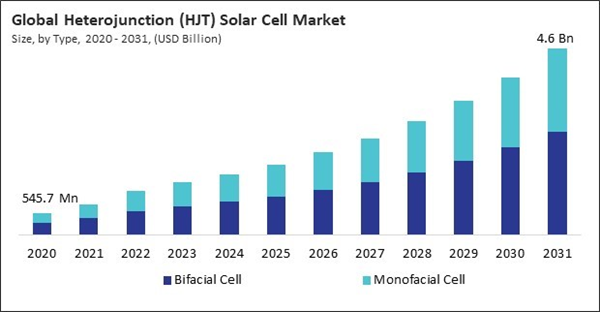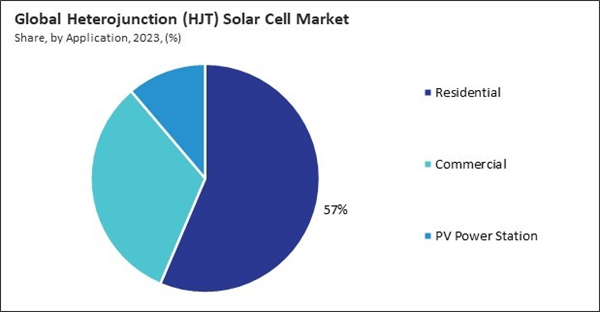The Global Heterojunction (HJT) Solar Cell Market size is expected to reach $4.6 billion by 2031, rising at a market growth of 17.3% CAGR during the forecast period.
The U.S. and Canada have shown increasing interest in high-efficiency solar solutions, driven by policy support such as tax credits, renewable portfolio standards (RPS), and growing consumer demand for sustainable energy solutions. Thus, the North American region would acquire nearly 20% of the total market share by 2031. The U.S. and Canada have shown increasing interest in high-efficiency solar solutions, driven by policy support such as tax credits, renewable portfolio standards (RPS), and growing consumer demand for sustainable energy solutions.
Technological advancements in manufacturing Heterojunction (HJT) solar cells have significantly made their production more cost-effective and sustainable. Moreover, these advancements have allowed for the scaling up of production without compromising the cells' efficiency. Hence, rapid technological developments will aid in the expansion of the market. Additionally, The solar energy sector is currently undergoing a substantial effort to improve the efficiency of solar technologies. Photovoltaic (PV) cells, at the heart of solar power technology, have traditionally converted sunlight into electricity at efficiencies ranging from 15% to 20%. Thus, the rising demand for more efficient solar cells will propel the expansion of the market in the coming years.
However, the increased costs associated with HJT technology are primarily due to its complex manufacturing processes and the premium materials required. Moreover, the materials used in HJT cells contribute significantly to their cost. For example, HJT technology frequently utilizes silver for the metalization process. These factors combined - complex manufacturing processes and expensive materials - make HJT solar cells a higher-cost option within the solar industry and may impede the market's growth.
The U.S. and Canada have shown increasing interest in high-efficiency solar solutions, driven by policy support such as tax credits, renewable portfolio standards (RPS), and growing consumer demand for sustainable energy solutions. Thus, the North American region would acquire nearly 20% of the total market share by 2031. The U.S. and Canada have shown increasing interest in high-efficiency solar solutions, driven by policy support such as tax credits, renewable portfolio standards (RPS), and growing consumer demand for sustainable energy solutions.
Technological advancements in manufacturing Heterojunction (HJT) solar cells have significantly made their production more cost-effective and sustainable. Moreover, these advancements have allowed for the scaling up of production without compromising the cells' efficiency. Hence, rapid technological developments will aid in the expansion of the market. Additionally, The solar energy sector is currently undergoing a substantial effort to improve the efficiency of solar technologies. Photovoltaic (PV) cells, at the heart of solar power technology, have traditionally converted sunlight into electricity at efficiencies ranging from 15% to 20%. Thus, the rising demand for more efficient solar cells will propel the expansion of the market in the coming years.
However, the increased costs associated with HJT technology are primarily due to its complex manufacturing processes and the premium materials required. Moreover, the materials used in HJT cells contribute significantly to their cost. For example, HJT technology frequently utilizes silver for the metalization process. These factors combined - complex manufacturing processes and expensive materials - make HJT solar cells a higher-cost option within the solar industry and may impede the market's growth.
Driving and Restraining Factors
Drivers- Rapid technological advancements in manufacturing
- Increasing demand for solar panels with higher efficiencies
- Growing number of government incentives and policies
- High production costs of HJT solar cells
- Emerging competitive technologies
- Rising corporate adoption and commitment to sustainability
- Significant investments in research and development
- Supply chain limitations for materials and equipment
- Limited scale of production
Application Outlook
On the basis of application, the heterojunction (HJT) solar cell market is classified into PV power station, commercial, and residential. The commercial segment recorded 32.74% revenue share in the heterojunction (HJT) solar cell market in 2023. Commercial entities, including businesses, schools, and government buildings, adopt HJT solar cells to cut down on operational costs and meet sustainability goals. The higher initial investment in HJT technology is often justifiable in commercial applications due to the long-term energy savings and potential for enhanced corporate responsibility toward environmental sustainability.Type Outlook
Based on type, the heterojunction (HJT) solar cell market is bifurcated into monofacial cell and bifacial cell. The monofacial cell segment procured 45% revenue share in the heterojunction (HJT) solar cell market in 2023. Monofacial HJT cells collect sunlight from only one side - the front. They are typically simpler and sometimes cheaper to manufacture than bifacial cells, making them suitable for traditional residential and commercial rooftop installations where the back side of the solar panel does not receive direct sunlight.Regional Outlook
Region-wise, the heterojunction (HJT) solar cell market is analyzed across North America, Europe, Asia Pacific, and LAMEA. The Asia Pacific segment witnessed 56% revenue share in the heterojunction (HJT) solar cell market in 2023. This is largely due to the substantial investments in renewable energy technologies by countries such as China, Japan, and South Korea. These nations have been at the forefront of advancing solar technology, supported by strong governmental initiatives, substantial manufacturing capabilities, and growing environmental awareness.List of Key Companies Profiled
- Reliance Industries Limited (REC Solar Pte. Ltd.)
- Jinneng Clean Energy Technology Ltd. (Jinneng Holding Group)
- Anhui Huasun Energy Co., Ltd.
- Jiangsu Akcome Science and Technology Co., Ltd.
- CANADIAN SOLAR INC.
- RISEN ENERGY Co., LTD.
- Enel S.p.A
- Meyer Burger Technology AG
Market Report Segmentation
By Type- Bifacial Cell
- Monofacial Cell
- Residential
- Commercial
- PV Power Station
- North America
- US
- Canada
- Mexico
- Rest of North America
- Europe
- Germany
- UK
- France
- Russia
- Netherlands
- Italy
- Rest of Europe
- Asia Pacific
- China
- Japan
- India
- South Korea
- Taiwan
- Australia
- Rest of Asia Pacific
- LAMEA
- Brazil
- Argentina
- Egypt
- South Africa
- Morocco
- Chile
- Rest of LAMEA
Table of Contents
Chapter 1. Market Scope & Methodology
Chapter 2. Market at a Glance
Chapter 3. Market Overview
Chapter 4. Global Heterojunction (HJT) Solar Cell Market by Type
Chapter 5. Global Heterojunction (HJT) Solar Cell Market by Application
Chapter 6. Global Heterojunction (HJT) Solar Cell Market by Region
Chapter 7. Company Profiles
Companies Mentioned
- Reliance Industries Limited (REC Solar Pte. Ltd.)
- Jinneng Clean Energy Technology Ltd. (Jinneng Holding Group)
- Anhui Huasun Energy Co., Ltd.
- Jiangsu Akcome Science and Technology Co., Ltd.
- CANADIAN SOLAR INC.
- RISEN ENERGY Co., LTD.
- Enel S.p.A
- Meyer Burger Technology AG
Methodology

LOADING...










